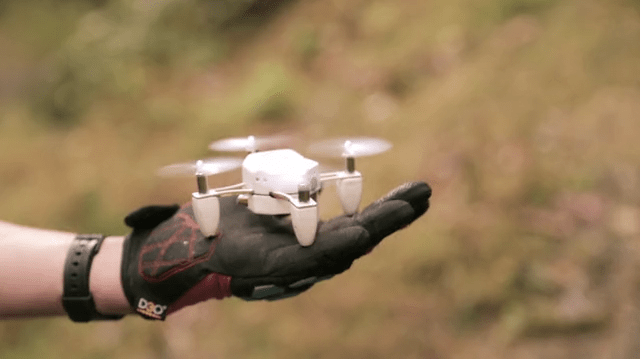Holy autonomous micro-drones batman! Wondering how you’re going to line up your next dronie? Aka a selfie taken from up high by a passing UAV so you don’t get a photo of yourself remote controlling a drone… Well, never fear: a U.K.-based firm is building a micro-drone that flies itself so you can stand around looking nonchalant/pull off some sick BMX/skateboarding/tombstoning tricks while being papped from above.
Called Zano, the micro-drone is currently a flying prototype, due to make it to market next summer. It’s being demoed on Kickstarter as its engineer makers, Torquing Group, seek to raise £125,000 to give their new baby lift off. At the time of writing they’ve already passed £100,000 raised and still have 42 days left on their campaign so expect Zano’s pledged funds to easily soar past the target.
The Zano micro drone is just 2.5 inches x 2.5 inches (and 55g in weight), with a 5 megapixel on-board HD video camera plus digital microphone — and optical image stablizing tech — to take decent stills and footage. Video resolution is capped to 720p because of initial bandwidth restrictions, although the on-board camera is capable of 1080p 60 fps — in other words better quality footage may be offered/unlocked in a future update.
To enable watchable footage and non-blurry dronies, Zano uses a variety of on board sensors for stable flight indoors and out. On board sensors include GPS, infrared for obstacle avoidance, echo sounding sonar and air pressure sensors for altitude control. It uses Wi-Fi to send footage back to the owner’s mobile device. Flight time per battery charge is slated as 10 to 15 minutes at this point. It has a 25mph top flying speed, and a 15 to 30 meter operating range (depending on the mobile device you’re using it with, and any local regulatory restrictions on UAVs).
Having a mix of positioning sensors enables Zano to determine its position relative to objects around it and thus maintain a set distance from your mobile device — when used in a “follow me” mode. It also means it can autonomously avoid obstacles in the process, so this is a drone that’s designed to take away the strain of flying a drone. What’s not to love? Zano can also apparently be set to maintain a particular position, to give you a static bird’s eye view on your scene, or further controlled by tilting the paired mobile device or using other controls in the companion app. Zano’s app will support iOS and Android.
Further micro-drone tricks in the works include tracking a set target via the follow me feature, a facial recognition capability, and swarming Zanos so a user could use multiple micro-drones to capture different perspectives on the same scene. These features will be offered as in-app purchases after Zano ships. The Kickstarter price-tag for the drone, which includes 12 months of “free capability updates” after its public launch, starts at £139 (~$220) .
The engineers behind Zano began working on the concept back in October 2013, after developing drones for military and law enforcement scenarios. How far along are they at this point? They have this to say on their Kickstarter page:
ZANO is up and flying, holding position, avoiding obstacles, streaming live video back to a smart device, capturing video and photos. However, with as much capability as we’ve packed into ZANO, we are continuing to refine the flight, avoidance, video and photo capturing and user interface, plus we have relentless testing and refining procedures prior to us releasing ZANO to the market. We will begin our BETA testing in March 2015. With a view to enter production in May 2015!
Update: A spokesman for the company elaborated on the outstanding developments for the project at this point — and it’s a pretty long list, topped off with the need to do a lot of testing next year. Technical stuff on the to-do list includes finalizing the flight frame circuit to include an SD card, finalizing obstacle avoidance systems, plus GPS and the audio board; finalizing production shape of the plastic components to send away for tooling and subsequent injection moulding; fitting in a pre-production pilot run of 500 Zanos to ironing out any production issues; plus about a month’s work on firmware adjustments and refinements to fail safes, optimization of image handling, object avoidance algorithms and more.
Also on the slate: building the iOS and Android apps, and contacting regulators to get UAC guidelines and ensure the drone’s capabilities remain within the law.
As with all crowdfunding projects — and especially those involving hardware — it’s worth stressing that estimated schedules routinely slip. So expecting dronie delays is the sensible option.
